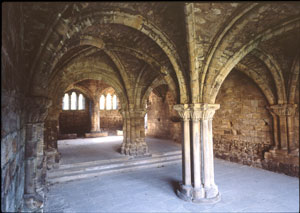 |
 |
 |
 |
 |
 |
 |
|
The Dissolution: the end of monastic life at Kirkstall (1/5)
The Dissolution of the monasteries by Henry VIII brought an end to monastic life at Kirkstall. Following the completion of the Valor Ecclesiasticus, the survey commissioned by the king to assess the value of the religious houses in the country, two royal commissioners, Doctors Layton and Legh, visited 121 religious houses in the North. They travelled over one thousand miles between spring 1535 and autumn 1536 to compile a report on the state of the religious life in the North, based on five pieces of information: the chastity of the monks, evidence of the veneration of relics, the financial state of the house, the name of the founder, whether any members of the community would agree to give up the religious life to take their place, once more, in secular life. During this grand tour of the North, Layton and Legh gained a reputation for their unpleasant manner and rigorous questioning. The couple arrived at Kirkstall after their visitation of Fountains and Ripon, and reported three cases of sodomy, veneration of an object said to be the girdle of St Bernard and promoted as an aid for women in child-birth, and an annual income of £329. The founder at this time was the king. These findings were recorded in the infamous ‘Black Book’ which was read out to Parliament in 1536 as evidence of the poor state of religious life. This paved the way for the first phase of the dissolution, the suppression of religious houses with an annual income under £200. Kirkstall, like most of the Cistercian houses in the North, escaped this first stage of suppression but finally surrendered in November 1539.
On 22 November 1539 Abbot John and his thirty monks gathered in the chapter-house at Kirkstall for the final time and surrendered their abbey to the royal commissioners. They appended their names to the surrender deed, handed over the keys of the abbey and resigned Kirkstall’s property to the Crown. Each member of the community was awarded a pension, an examination of the full list of the pensions granted to the monks reveals that the actual amount each recieved was dependent on how long the monk had been ordained and that those who were not priests received the meagre sum of £2 p.a. |
|||
